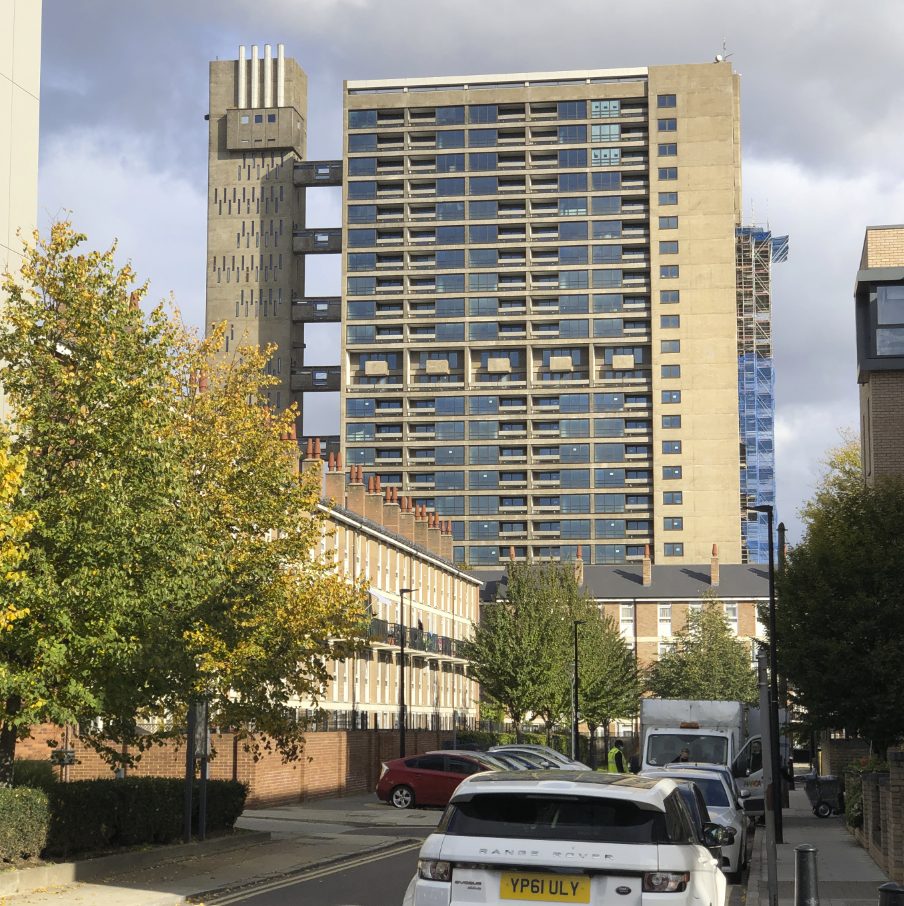Balfron Tower lead architect Ab Rogers made bold claims that he was “honouring the ghost of Goldfinger”, but it appears that Goldfingers ghost may be having the last laugh.
Despite two high profile marketing campaigns for the private sale of all 146 flats in the Ernö Goldfinger designed brutalist Balfron Tower, all flats have now been withdrawn from the market.
The sales effort for Balfron Tower was launched in Summer 2019 with a high profile sales campaign, with marketing featured across a broad range of mainstream media, including The Guardian and the Financial Times, yet genuinely interested buyers appeared to be thin on the ground and the project appeared to be going seriously off the rails.
Balfron Tower was then withdrawn from sale in early 2020 and throughout the pandemic scaffolding once again climbed this 27-storey tower, where it remained for well over a year.
There appeared to be some significant structural problems with the tower.
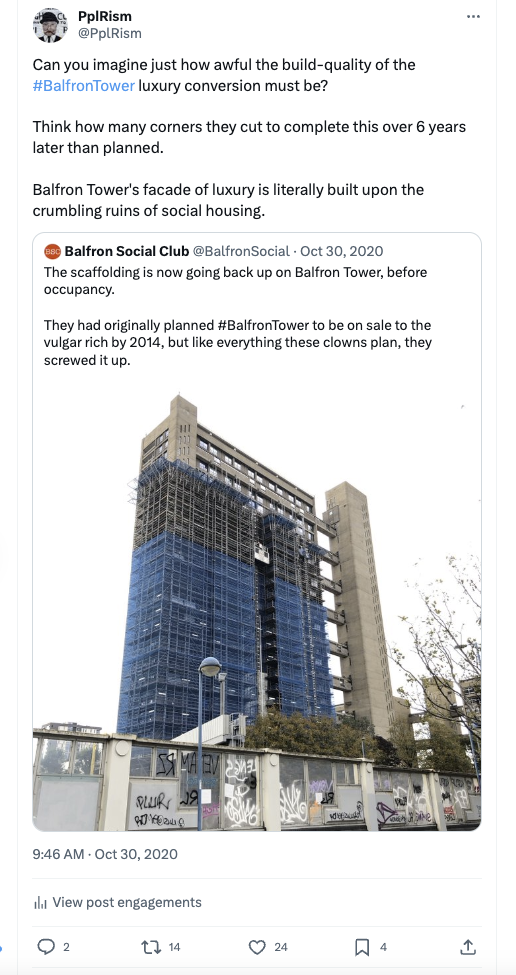
Meanwhile, leaseholders were waiting to return to their homes.
One elderly leaseholder, Hugh Thompson, 86, has been living out of a suitcase in a hotel since he was forcibly decanted from his home in Balfron Tower in 2016 so that regeneration works could commence.
Initially, he was told that the construction works would take two years, although following a one year delay to the commencement of the project, after the tenants had all been decanted, he was then told that he could return to his home in 2019.
After three years in a hotel, the novelty had worn off and he was eager to return home.
On several further occasions Poplar Harca advised Thompson that he could return to his 21st floor home, which he bought in the 1980’s from Tower Hamlets council under Right to Buy legislation.
Yet, on each occasion he was let down at the last moment and told that he could not return home.
Second marketing campaign
In the Summer of 2022, Poplar Harca launched a second high profile marketing campaign, managed by PR firm Good Relations, perhaps best known for their connection to Bell Pottinger and their legacy of stirring up racial tension in South Africa.
Harca scored a second feature article in The Guardian by Oliver Wainwright, as well as features in the Daily Mirror and The Sun and a collaboration with registered charity Open House to market the socially-cleansed flats via Rightmove and their Open House events.
Harca Lies
Despite Harca’s claims in The Guardian that “more than 1,200 interested buyers have already signed up”, it appears that there has actually been so little genuine interest in actually buying one of these architecturally mutilated flats that they have all now been withdrawn from the market.
Poplar Harca openly boasted that they have sold Flat 130, the home for two months in 1968 of Balfron Tower’s infamous architect Ernö Goldfinger, yet the Land Registry does not include the details of sales of any property in Balfron Tower since Flat 102 changed hands to Balfron Tower Developments LLP for £1,480,000 in 2017.
This transaction raises serious questions about the legitimacy of some of the transactions, and who they may have benefitted.
Poplar Harca openly boasted in BD Online in 2008 that one of the project team had already bought one of the flats, for cash.
Balfron Social Club reiterates our call for an independent audit of Poplar Harca.
The human cost of regeneration

Photograph from Inversion / Reflection: Turning Balfron Tower Inside Out by Rab Harling
As for leaseholder Mr Thompson, did he get to return to his flat as was promised in Autumn 2022, six years after he moved out, following the second expensive, high-profile marketing campaign?
In short, no. No, he did not.
Mr Thomson has recently been told it will now be September 2023 before he can return home, over seven years since he was forced out.
Seven years in a hotel, in his 80’s.
Hugh’s story is just one brutal story from a catalogue of abuse residents suffered at the hands of Poplar Harca and its staff who appear to thrive on bullying residents, who are treated more as an inconvenience than a community, especially social tenants who live in blocks earmarked for regeneration.
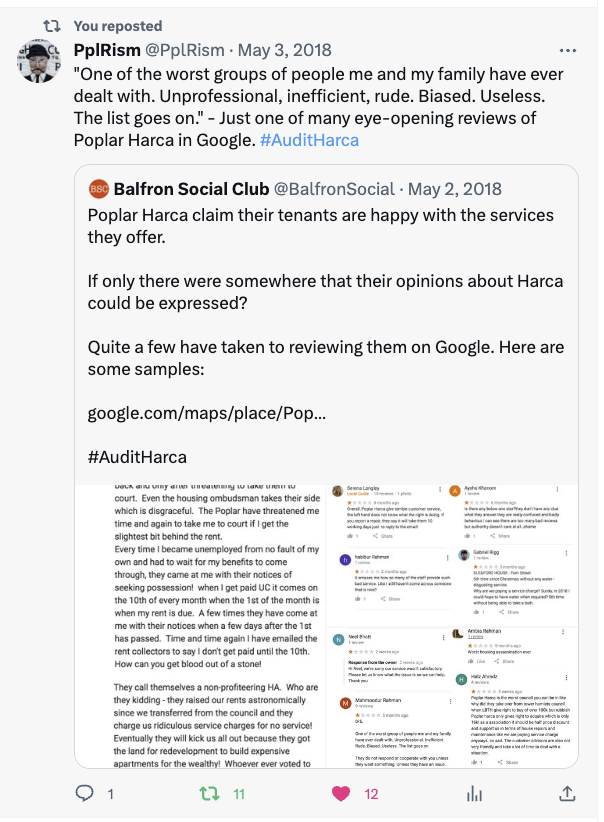
This arrogant attitude towards local people appears to stem from the very top of Poplar Harca and filters its way down though its directors, who appear to treat Poplar as their own personal fiefdom, and where telling lies to tenants seems to come as second nature.
Meanwhile, Poplar Harca directors were happily associating themselves with some very sleazy individuals, such as developers London Newcastle, highly indicative of the management style emanating from Harca under its CEO, Steve Stride.
References are still often made of the “Balfron Tower casting couch”, the nickname for a nicely decorated flat that was forcibly appropriated by Poplar Harca during Bow Arts so-called Balfron Season in 2015, where agencies such as Arts Council England, English Heritage and British Council turned Balfron Tower into their own personal playground and assisted Bow Arts and Poplar Harca with artwashing the social cleansing of Balfron Tower, all whilst social tenants, yet to be decanted, remained living in the tower.
Poplar Harca also made the flat available to London Newcastle, Telford Homes, Bow Arts and any of their friends to use, as they chose.
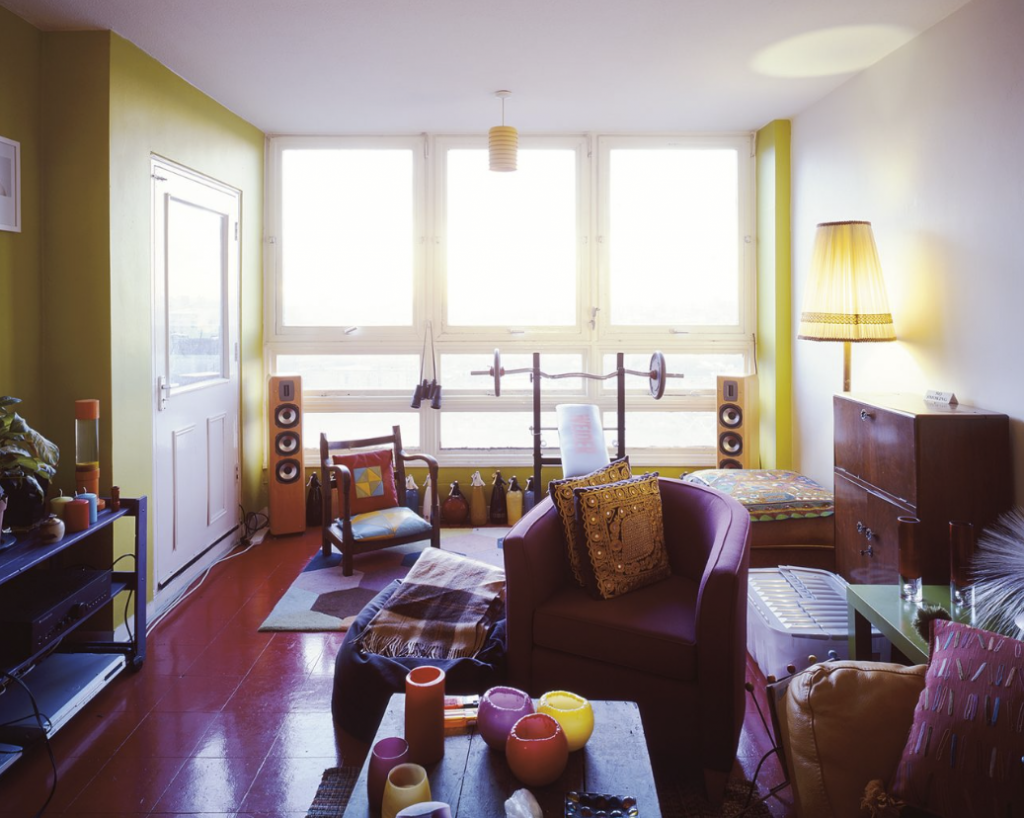
Photograph from Inversion/Reflection: Turning Balfron Tower Inside Out by Rab Harling
Poplar Harca’s arrogant attitude towards the local community has ensured that local people have always been hostile towards the regeneration of Balfron Tower.
All social housing was removed from Balfron Tower in a plan that cast local people aside, often to estates already earmarked for demolition creating chaos into the lives of the local population, in order to provide homes for office workers at the nearby Canary Wharf financial district, and took very little consideration for the needs of the local community.
They only cared about the value of the homes people occupied and their desperate attempts to gentrify the community by attracting financial workers to the neighbourhood.
The community has not forgotten the brutal treatment by Poplar Harca staff, who bullied and harassed our friends and neighbours from their homes, and intimidated, even stalked, anybody that dared criticise them or obstruct them in any way.
Is anybody really surprised that Poplar Harca’s plans to sell all the flats in Balfron Tower have been a total disaster?
I suspect they alone are, because if Harca are known locally for anything, its for not listening to the needs and requirements of local people, as they court people they want to live in the area rather than those who already do.
They were never listening, they decided what they wanted to do and then went ahead and did it, regardless of the needs of the local community, and just like the Tower Hamlets Labour Party, who lost control of the council at recent elections, their time is up.
What’s next for Balfron Tower?
“The private sales operation for Balfron has been put on hold. The developer (Balfron Tower Developments LLP) has now made a decision to convert the newly renovated homes which had been proposed for sale, to professionally managed rented homes (‘Build to Rent’ or BTR). Subsequent to this Savills have since been appointed to market the BTR element to prospective investment partners.”
It now appears that Poplar Harca, a Registered Social Landlord, that was given vast swathes of Poplar free of charge by the former Labour council, have decided to convert the homes in Balfron Tower into “professionally managed rented homes” using the government’s Build to Rent scheme.


It would seem unlikely that the regeneration of Balfron Tower should be eligible for a government scheme designed for large landlords who have specifically built new-build properties solely for the rental market, but if there is one thing that Poplar Harca & Co. are good at, its lying and cheating their way into large amounts of public funds.
If somehow they do manage to achieve their new aim of Build to Rent then this would ensure that, according to the terms of the Build to Rent scheme, at least 20% of the homes being made available for rent must be made available as “affordable rent” properties, for the long-term.
Balfron Social Club believes that the ghost of Goldfinger will never be happy until Balfron Tower is returned to its intended social purpose.
Balfron Social Club started in 2014 with a campaign for 50% social housing to be retained in the regeneration of Balfron Tower.
Poplar Harca, backed by a Labour council led by (now-former) mayor John Biggs, insisted that there would be absolutely no social housing retained in the tower and that all flats would be sold on the private market.
Now the market has concluded that there are to be no sales on the private market, Poplar Harca plans to rent the properties privately instead.
We do not believe that a token 20% “affordable rent” properties in the tower is acceptable, and we demand that all unsold flats are now returned to the socially rented sector, to help relieve some of the pressure upon people in Tower Hamlets, people in desperate need of genuinely affordable social housing.
Sack Steve Stride
Poplar Harca’s risky top-down plans to gentrify Poplar have failed, and its time for Steve Stride to be sacked, and for the Poplar Harca housing stock to be transferred back to the management of Tower Hamlets council, as has recently happened to Tower Hamlets Homes, under the direction of Tower Hamlets new mayor, Lutfur Rahman.
Meanwhile, 146 families on the Tower Hamlets housing waiting list can be housed in this recently refurbished, purpose-built social housing block, with great views across London.
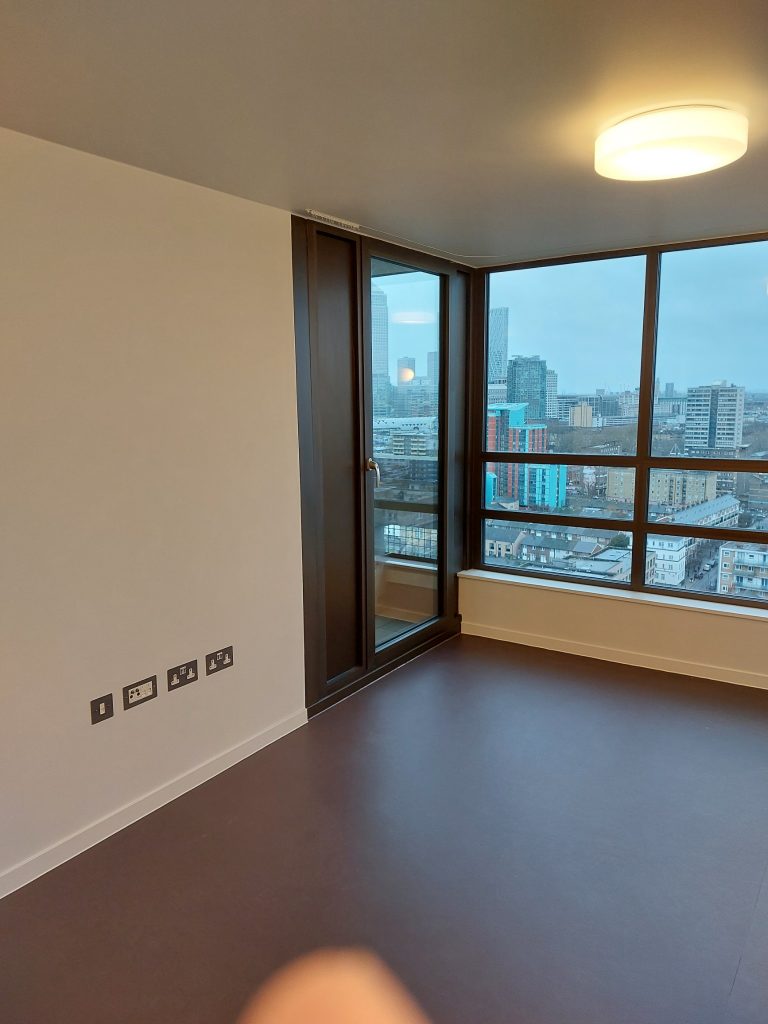

Balfron Social Club
Poplar. 2nd April 2023.
Find us on twitter: https://twitter.com/BalfronSocial
Have you seen “What Does Balfron Tower Mean to You? a short film by Rab Harling?


